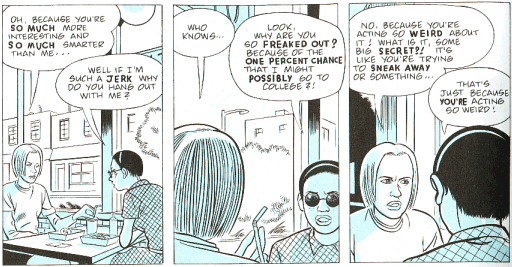

| July 1998 |
|
| Daniel Clowes: Ghost World | |
But nothing in his earlier work prepared me for Ghost World, which broadens Clowes' range immeasurably and stretches the whole genre along with it.
It's amazing stuff. Go read it. Yes, right now.
 It's the story of two teenage girls, Enid and Rebecca, best friends since forever, hanging out during the summer after senior year. Clowes has the language and the mannerisms of adolescence down: the disdain, the longing, the feeling of having figured out the world and the fear of plunging into it. Like Clowes himself, the girls are connoisseurs of losers and dorks; they seek out lame comedians on TV, play cruel tricks by telephone, find the perfect tacky '50s diner. They tease each other, confess, egg each other on, fight, make up, and find, in the end... well, you'll just have to read it.
It's the story of two teenage girls, Enid and Rebecca, best friends since forever, hanging out during the summer after senior year. Clowes has the language and the mannerisms of adolescence down: the disdain, the longing, the feeling of having figured out the world and the fear of plunging into it. Like Clowes himself, the girls are connoisseurs of losers and dorks; they seek out lame comedians on TV, play cruel tricks by telephone, find the perfect tacky '50s diner. They tease each other, confess, egg each other on, fight, make up, and find, in the end... well, you'll just have to read it.
Don't worry, there's no deaths at the end or anything. Velvet seems to have gotten that out of his system. His patented creepiness is on view here, but toned down considerably. In fact I can't think of another comic that has the same combination of reportorial reality and storytelling ability. (No, not even Jaime Hernandez, who's more stylized; or Jessica Abel, whose slices of life are sometimes too pointless.)
As for the drawing-- God, it's beautiful. It's two-tone, with a light blue wash that deepens the drawings without getting in the way-- highlights the forms without losing the texture of the drawing. It's way better than full color, at least for American comics. Hate changed to color seemingly because Fantagraphics figured that real Amurricans want their comics in color, dammit. But color doesn't do anything for Pete Bagge. Clowes's color accomplishes the same minor task-- getting past the flatness of black and white-- but without the descent into paint-by-numbers banality that's the fate of most American color comics.
(I can't help pointing out that Clowes doesn't seem interested in drawing arms-- it's heads that turn him on-- and this occasionally makes the figures look a bit strange. But-- it just doesn't matter. It gives the drawings that patented Eightball feeling-- the sense that Clowes's muse lives in the '50s, as Seth's lives in the '40s.)
You could imagine Ghost World as a quiet, edgy little indy film... and Terry Zwigoff, auteur of Crumb, could as well; he and Clowes are trying to film it. Read it now so you can complain about it once it comes out.
This just in: The movie is out. Here's my thoughts on it..
| Scott McCloud: Zot! | |
Zot, or Zachary T. Paleozogt, is a teenager from an alternate earth, and a superhero-- an old-fashioned superhero, à la Batman or the Spirit, from a time when you didn't need mutant powers or the ability to destroy a planet to be a superhero, just some flying boots your Uncle Max rigged up, a flashy gun, and a steady supply of wisecracks.
The art is spotty-- McCloud is no architect or villain designer (I cringed when I saw Dekko), the coloring is atrocious, and he evidently hadn't read Moebius yet-- but the writing is better than you could hope, and it grows on you. In the first volume, reprinting the ten-issue color run of the comic, McCloud doesn't get far from Marvel-land-- furious plotting, nefarious villains pursuing Eeevil, a conveniently omnicompetent mechanical genius, cute backup characters, a little character development in between the battle scenes, a vague message against dictatorship and in favor of a mild spirituality. But it's all well done, and the characters are lively: Jenny, Zot's melancholic friend from Earth; her brother Butch, who following a little accident has turned into a chimpanzee; Prince Drufus, Sirius IV's less than adequate answer to Zot; and above all 9-Jack-9, a charming and quite deadly electronic villain.
There's signs, toward the end, that McCloud wants to do something more, question the whole superhero thing; Zot even asks, "Isn't justice more than just a punch in the nose?"
The color series was cancelled before that question could be answered; and in the interregnum McCloud offered further reflections on the subject in the form of Destroy!, an oversize comic consisting of 32 pages of two musclebound oafs beating the hell out of each other and, incidentally, destroying New York.
He then returned to Zot! as a black & white book for twenty more issues; the first of three volumes reprinting this run is just out. The book is immediately improved by the abandonment of the garish colors and garish story elements of the first volume. B&W also allows McCloud to show off some of the experiments and expressionism that come to dominate his post-Zot work-- best seen here in the Fleeneresque madman's-eye-view panels in the Dekko story.
Other highlights include the fulminating, Verne-esque villain, Dr. Bellows; the slowly developing romance between Zot and Jenny, and a planetwide wave of inexplicable dancing.